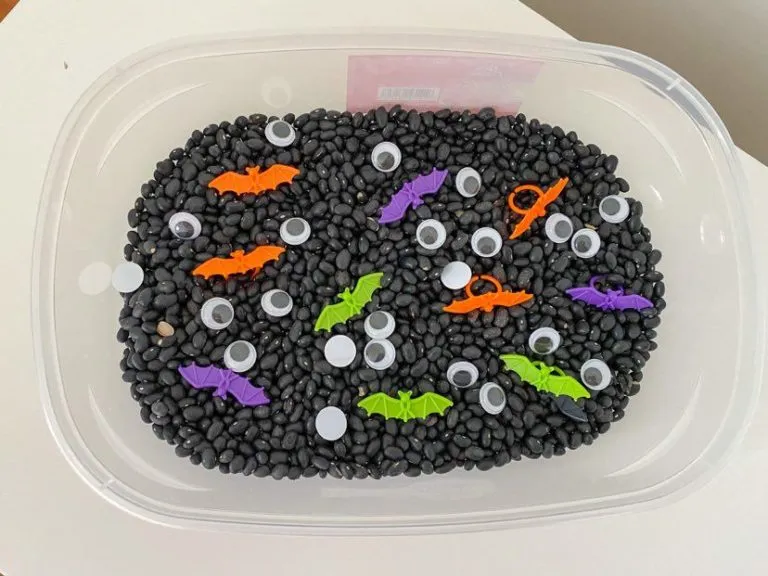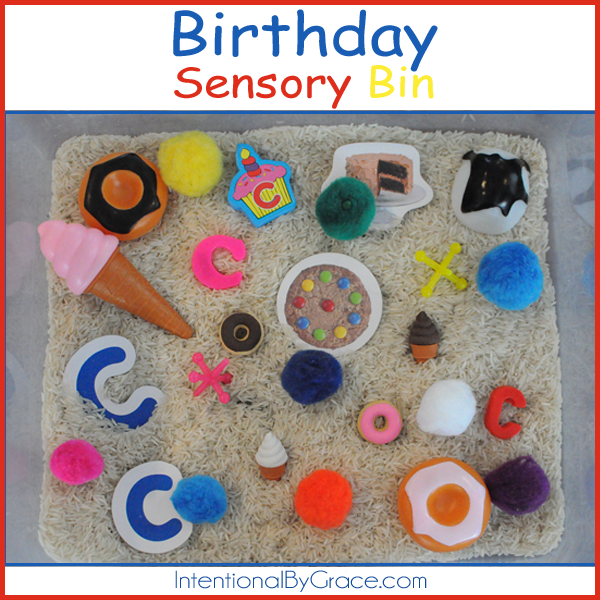Stuck inside on a rainy day with the kids? Try a sensory bin! What is a sensory bin? It is a container filled with various textured items. It can be simple with just one texture, like oatmeal or dried beans. Or the sensory bin can contain a wide range of items like water with rocks, toy fish, and a net. When it comes to sensory bins, the sky is the limit! Check out some of the ideas below to deepen your child’s senses.
Water Sensory Bin Ideas
1. Pom-Pom and Water
Here’s a cool water idea where your littles will get to fish for pom-poms! Simply fill a container with water and a whole bunch of colorful pom-poms before encouraging your class to use various tools to scoop, mix, and empty the container. If your little brainiacs are up for the challenge, you could even task them with matching pom-poms to colored pieces of paper.
Learn More: Learning and Exploring Through Play
2. Toys in Water
Toddlers will learn about the properties of water when they see that some items sink and others float. All you have to do is put the toys they already have in the water! You can add water bottles or colorful water beads to this bin for some additional flare.
Learn More: Minnie Mama
3. Household Items
Once your child is a little older, you can make a water table with random household items, like this mason jar and funnel. Add in dish detergent to make this box for toddlers full of soapy water.
Learn More: Daniel Boone Regional Library
4. Colored Water Stations
Here’s an imaginative play activity. Have food color assortments to add to your water table. You can have the color purple, as shown here, the color yellow, or your toddler’s favorite! Bright colors are sure to add fun and excitement to this sensory box idea.
Learn More: Jady A.
5. Kitchen Sink
Looking for accessory play ideas? Add any dish accessory or sponge to this kitchen sink and let your child run the tap as long as they’d like. The water basin holds enough water to allow your toddler to fill and re-fill the sink over and over.
Learn More: Lovevery
6. Measuring Cups
Your adorable monster has never been cuter than when they are playing with kitchen items. This is an awesome multi-sensory activity that will help your child grab handles and learn how they can collect and pour liquids.
Learn More: Things To Share And Remember
Rice Sensory Bin Ideas
7. Colored Rice
This rainbow rice sensory bin is sure to excite all curious toddlers. Color sensory is great for toddlers’ developing eyes and is sure to create some happy toddler playtime.
Learn More: Pocketful of Parenting
8. Dry Rice Filling Station
Take the colored rice you learned how to make above and add some household items. Although not pictured here, Ziplock bags can be filled with rice so toddlers can feel how it moves in contained spaces. Be sure there is always supervision when using plastic bags.
Learn More: Busy Toddler
9. Blue Rice
Are you not wanting to get involved with food coloring? No worries, this kit has you covered! The shiny gems will provide color reflection sensory as your toddler engages in open-ended play with this beach theme kit.
Learn More: Amazon
Bean Sensory Bin Ideas
10. Assorted Loose Beans
This Fall-themed sensory bin is sure to provide a soothing experience for your little ones. Simply fill a large container with an assortment of beans before inviting your kiddos to use tools such as scoops, tongs, and spoons to toss the beans around or add them to a sorting tray.
Learn More: Engaging Littles
11. Black Beans

Holiday sensory fun with googly eyes! Because of the small pieces, this one is certainly for ages from toddlers and up. Spider rings can be added for insect sensory fun. Once this BINS for toddlers is done being played with, kids can play and can wear the rings!
Learn More: Simply Special Ed
12. Colored Beans
Fantastic fun and learning start with colors! Whether you’re creating simple primary colors or the whole rainbow, dying beans are a great way to start. The rainbow beans pictured here can become a fun theme sensory idea with a cut-out of the sun, clouds, and some raindrops for an all around learning experience.
Learn More: Active Littles
Animal Sensory Bin Ideas
13. Baby Birds and Shredded Paper
I love this autumn-colored shredded paper. Use crinkle paper as the bird’s nest and add pipe cleaners for worms! What a fun sensory experience for kids as they learn about a bird’s habitat. Add some sticks from the garden and find a real bird’s feather to add to the experience.
Learn More: Modern Preschool
14. Farm Animals
Now, this is truly a fun idea! Use these farm gates to create animal mazes. The craft sticks pictured in the lower left corner are being used as a pig pen. Get your kiddo involved with painting the craft sticks before collecting colored pebbles for this sensory play idea.
Learn More: Living Montessori
15. Awesome Animal Zoo Sensory Bin
This bright and colorful sensory bin is sure to be a hit with those little animal lovers in your class! Simply fill a container with four sets of colorful beans to represent four different animal habitats, from the African desert to icy Antarctica. Next, place toy animals like giraffes, polar bears, and tigers in each corner before inviting your tots to explore each habitat.
Learn More: Creative Projects for Kids
Food Item Sensory Bin Ideas
16. Jell-O Sensory Bins
Check out these cute dinosaur figurines! Fantastic fun and learning will occur as your child squishes Jell-O to get the toys out. Talk about texture overload! The best part? Kids can eat the Jell-O as they play in this sensory bin. You can do multiple colors as pictured here, or just one. Be sure to add the toys before placing the Jell-O in the fridge.
Learn More: Jady A
17. Corn Flour Paste

This sludge paste can be made with items in your pantry. All you need is corn flour, water, soap, and food coloring. If you don’t have food coloring, that is completely fine; it just means your paste will be white. Allow your child to explore the feeling of the paste, or add toys for a more varied playtime.
Learn More: Pickle Bums
18. Cloud Dough
Oil and flour are all you need for this sensory bin. This is the perfect non-toxic option for kiddos who are constantly putting things in their mouth. I would take this messy one outside on the deck for some cool springtime fun!
Learn More: This West Coast Mommy
19. Corn Pit
Autumn colors unite! Use corn kernels for this fun and festive idea. Older kids can work on their chopstick skills as they try to pick up kernels.
Learn More: Still Playing School
Other Sensory Bin Ideas
20. Shaving Cream Sensory Bin
Just a spot of food coloring here and there on dad’s shaving cream is all you need for this one. Kids will love the foamy texture.
Learn More: Taming Little Monsters
21. Artificial Flowers
Check out these beautiful flowers! In this sensory bin activity, you’ll fill a container with a bunch of beans or rice before adding in a few artificial flowers. Your children are then free to scoop, pour, or sprinkle the beans around the flowers.
Learn More: Toddler at Play
22. Dinosaur Sensory
This kit has everything you need to be an archeologist! Uncover fossils, feel the sand, and play with dinosaurs in this readymade package.
Learn More: Amazon
23. Beach Sensory Bin Idea
The Beach theme is always in style! Gelatin, water, flour, oil, and coconut are all that is needed to create the blue jelly ocean pictured here.
Learn More: My Bored Toddler
24. Birthday Party Sensory

Using rice as your base, add birthday candles and goody bag items to this birthday sensory bin. Make it a play station at your next birthday celebration!
Learn More: Made to Give Life
25. Scarves in a Box
Take an old tissue box and fill it with silk scarves. Babies will work on their back muscles as they pull the scarves out of the hole. Try tying multiple scarves together to create one super long scarf.
Learn More: Mama OT